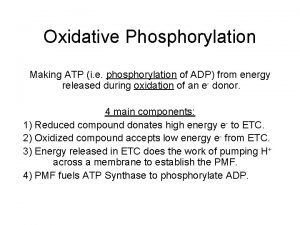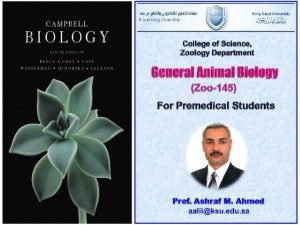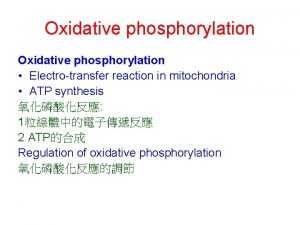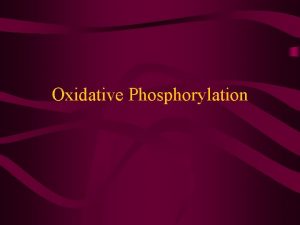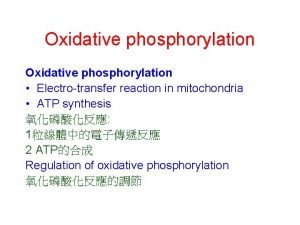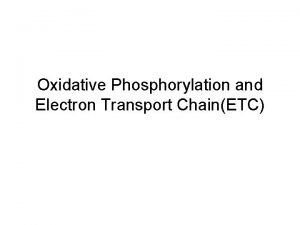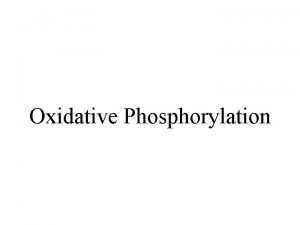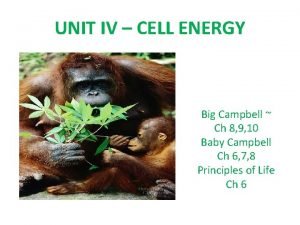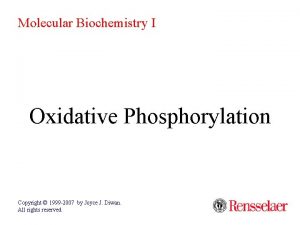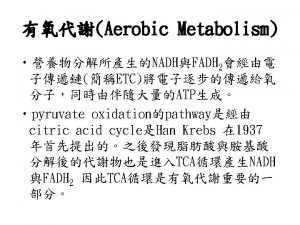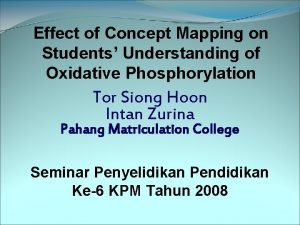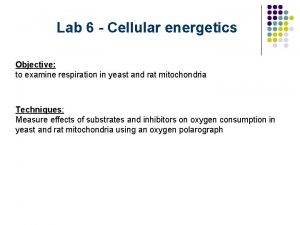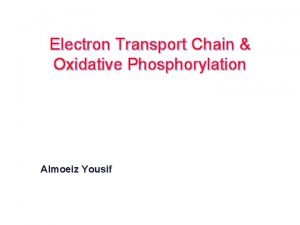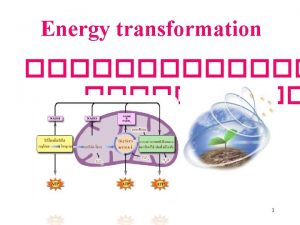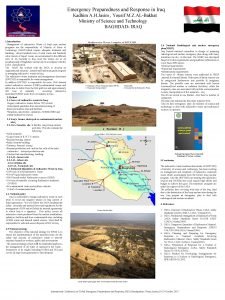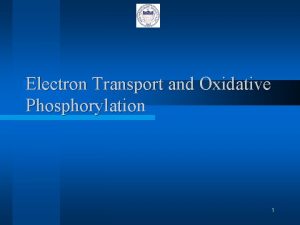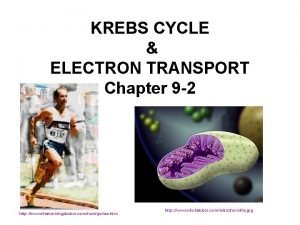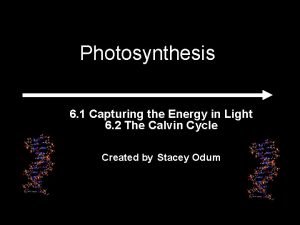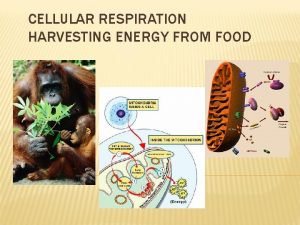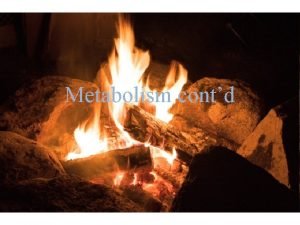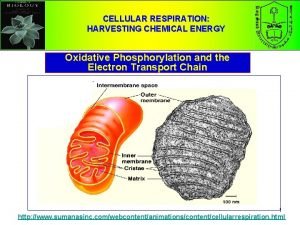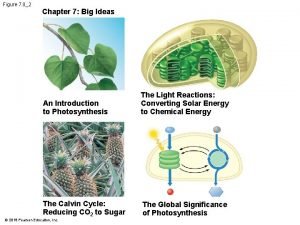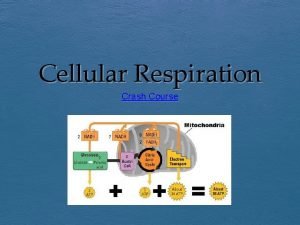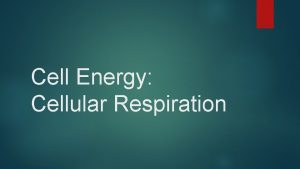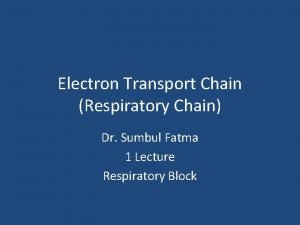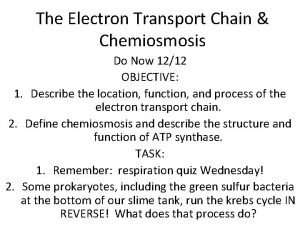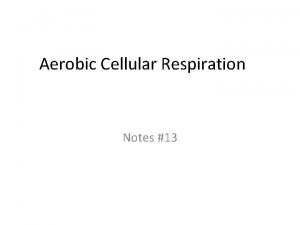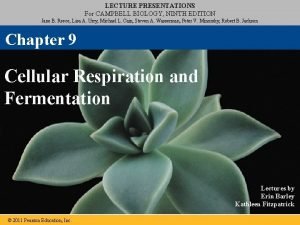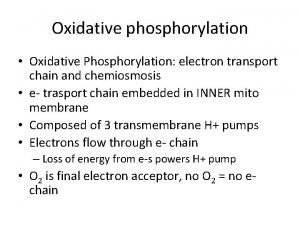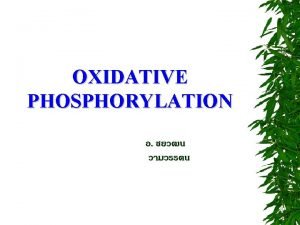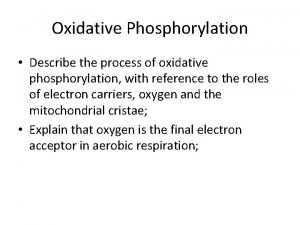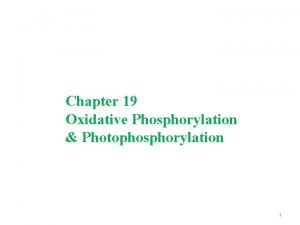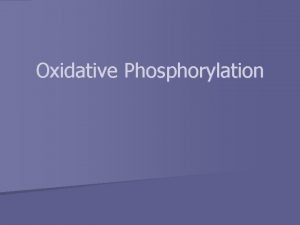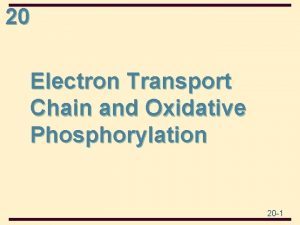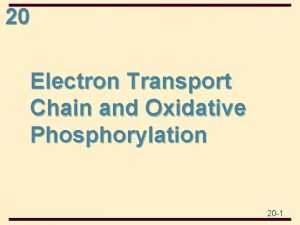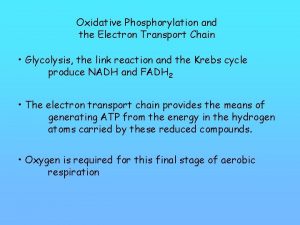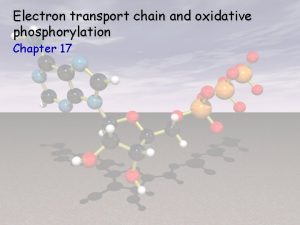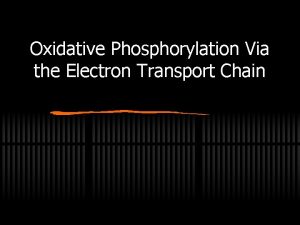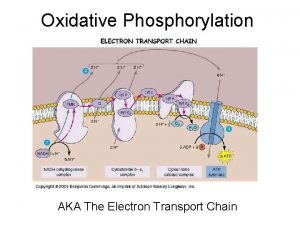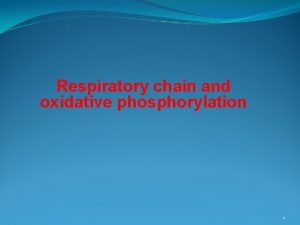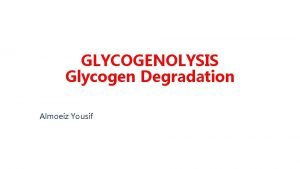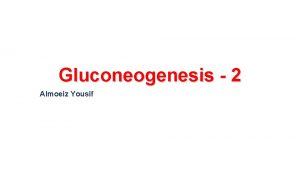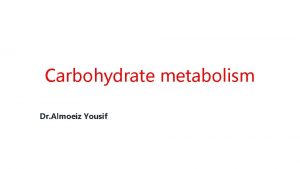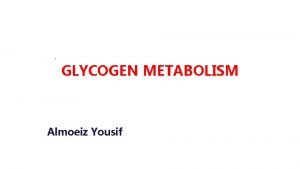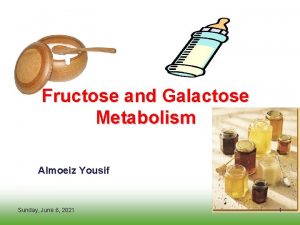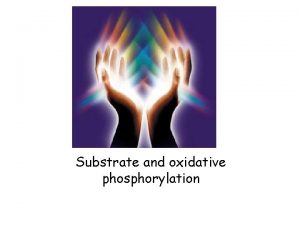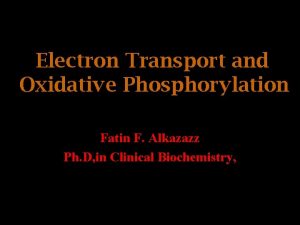Electron Transport Chain Oxidative Phosphorylation Almoeiz Yousif 2






























- Slides: 30

Electron Transport Chain & Oxidative Phosphorylation Almoeiz Yousif

2

What’s the point of oxidizing food? ATP The Point is to Make ATP! Monday, November 30, 2020 Almoeiz Yousif 3

When oxidizing food, the reduced coenzymes NADH and FADH 2 are produced. • NAD+ + 2 e- + 2 H+ → NADH + H+ • FAD + 2 e- + 2 H+ → FADH 2 Monday, November 30, 2020 Almoeiz Yousif 4

NADH 5

Oxidizing glucose • NADH is produced from glycolysis • NADH is produced from converting pyruvate to acetyl Co. A • NADH and FADH 2 are produced from citric acid cycle • These CAN be used to produce ATP! Monday, November 30, 2020 Almoeiz Yousif 6

Definition of Oxidative Phosphorylation Process by which ATP is formed by oxidizing NADH or FADH 2 7

1. ELECTRON TRANSPORT CHAIN (NADH → NAD) 2. OXIDATIVE PHOSPHORYLATION ( ADP → ATP) ATP synthesis Monday, November 30, 2020 Almoeiz Yousif 8

Monday, November 30, 2020 9

General properties • Takes place in the inner mitochondrial membrane • Only in presence of O 2 (aerobic) • Produces LOTS of ATPs. yields ~34 ATP from 1 glucose! Monday, November 30, 2020 Almoeiz Yousif 10

11

Electron Transport Chain Four complexes found on the inner mitochondrial membrane. • Complexes I, III, IV • Complexes I, II and IV are embedded within membrane. They are all fixed. 12

Ubiquinone is lipid-soluble, so it is found inside membrane. cytochrome c is water-soluble, found above membrane. Ubiquinone and cytochrome c are mobile. Monday, November 30, 2020 Almoeiz Yousif 13

Mitochondrial Electron Transport Chains Very similar to standard bacterial aerobic respiration chains 14

Complex I • NADH dehydrogenase • Transfers e- from NADH to Ubiquinone. Monday, November 30, 2020 15

Complex II • Succinate dehydrogenase • Transfers e- from FADH 2 to Ubiquinone 16

Complex III • Cytochrome c reductase. • Transfers e- from Ubiquinone to cytochrome c.

Complex IV • Cytochrome c oxidase • Transfers e- from cytochrome c to O 2. ½ O 2 + 2 H + + 2 e- H 2 O

functions of each of 4 complexes • complex I- accepts electrons from NADH, passes to: • Complex II- accepts electrons from FADH 2 and then passes to: • Complex III- accepts electrons from I and II, passes to: • Complex IV- accepts electrons from III and transfers them to oxygen Monday, November 30, 2020 Almoeiz Yousif 19

What is ETC ? It is the final common pathway by which electrons derived from NADH and FADH 2 of the body flow to oxygen. 2 H+ + ½ O 2 +2 e- Monday, November 30, 2020 Almoeiz Yousif H 2 O 20

Monday, November 30, 2020 Almoeiz Yousif 21

Monday, November 30, 2020 Almoeiz Yousif 22

ATP from Glucose For the complete oxidation of 1 glucose molecule Glycolysis 8 ATP 2 Pyruvate to 2 Acetyl Co. A 6 ATP 2 Acetyl Co. A to 4 CO 2 24 ATP Glucose + 6 O 2 6 CO 2 + 6 H 2 O + 38 ATP Monday, November 30, 2020 Almoeiz Yousif 23

INHIBITORS • Inhibitors of electron transport chain • Inhibitors of oxidative phosphorylation • Uncouplers of oxidative phosphorylation Monday, November 30, 2020 Almoeiz Yousif 24

Inhibitors of oxidative phosphorylation u. Blocking. The antibiotic oligomycin blocks the flow of H+ directly inhibiting ATP synthesis. Monday, November 30, 2020 Almoeiz Yousif 25

26

Uncouplers An uncoupling protein is a mitochondrial inner membrane protein that can dissipate the proton gradient before it can be used to provide the energy for oxidative phosphorylation Monday, November 30, 2020 27

Uncouplers • Does uncoupling serve any useful purpose? – body heat generation Monday, November 30, 2020 Almoeiz Yousif 28

Uncoupled e- Transport & Heat • Nonshivering thermogenesis An uncoupling protein (thermogenin) is produced in brown adipose tissue of newborn mammals and hibernating mammals. This protein of the inner mitochondrial membrane functions as a H+carrier. – Energy from ETC is released as heat. http: //www. trudicanavan. com/b-baby. jpg

 The stages of cellular respiration
The stages of cellular respiration Inhibitor of oxidative phosphorylation
Inhibitor of oxidative phosphorylation Substrate level phosphorylation vs oxidative
Substrate level phosphorylation vs oxidative P 450
P 450 Define oxidative phosphorylation
Define oxidative phosphorylation Oxidative phosphorylation energy yield
Oxidative phosphorylation energy yield Uncouple oxidative phosphorylation
Uncouple oxidative phosphorylation Inhibitors of oxidative phosphorylation
Inhibitors of oxidative phosphorylation Uncouplers of oxidative phosphorylation
Uncouplers of oxidative phosphorylation Substrate level phosphorylation
Substrate level phosphorylation Uncouplers of oxidative phosphorylation
Uncouplers of oxidative phosphorylation Uncouplers of oxidative phosphorylation
Uncouplers of oxidative phosphorylation Concept map redox reactions
Concept map redox reactions Energetics of oxidative phosphorylation
Energetics of oxidative phosphorylation Thermogin
Thermogin Oxidative phosphorylation
Oxidative phosphorylation Yousif kadhim accident
Yousif kadhim accident Electron transport chain
Electron transport chain The krebs cycle
The krebs cycle Electron transport chain
Electron transport chain Citric acid cycle and electron transport chain
Citric acid cycle and electron transport chain Electron transport chain
Electron transport chain Phosphorelation
Phosphorelation Electron transport chain
Electron transport chain Cellular respiration songs
Cellular respiration songs Electron transport chain cellular respiration
Electron transport chain cellular respiration Components of respiratory chain
Components of respiratory chain Chemiosmosis steps
Chemiosmosis steps Electron transport chain cellular respiration
Electron transport chain cellular respiration Aerbobic
Aerbobic Electron transport chain campbell
Electron transport chain campbell

